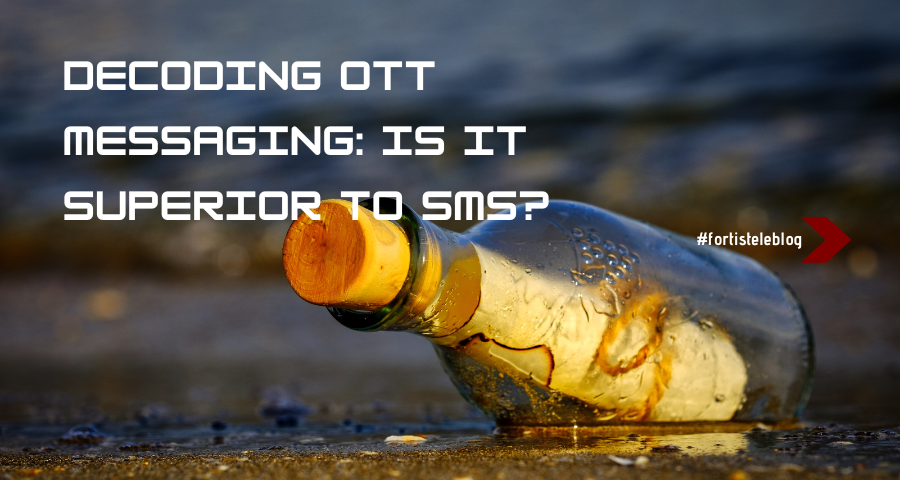Businesses looking to build a comprehensive marketing and communications strategy must utilize all possible channels to reach customers effectively. OTT messaging is one channel that’s gained popularity in recent years for business communication. But what is it? And how does OTT messaging stack up against traditional SMS messaging? Discover the pros and cons of each channel, plus several business use cases for OTT messages, in this article.
What is OTT messaging?
OTT is an abbreviation for ‘over-the-top’. OTT messaging apps are third-party instant messaging platforms that use an internet connection to transmit communication instead of a mobile network. In that regard, they operate ‘over the top’ or ‘above’ mobile networks.
Like the Short Message Service (SMS), OTT messaging is designed to reach recipients via their mobile phones. Think of it as an alternative to traditional texting.
How OTT messaging differs from SMS
The main difference between OTT messaging and SMS is that the former is WiFi based; SMS utilises only cellular networks for transmission. Some other points of difference are:
- OTT messaging doesn’t necessarily require a phone number, but SMS does (or some sort of sender ID).
- OTT messaging requires recipients to download a third-party app on their mobile phone; otherwise, they won’t be able to receive your messages. However, SMS is built-in as a native app on every mobile phone (e.g. Google Messages on Android devices).
Types of OTT messaging apps and platforms
You’ll probably have heard of, or be using, some of the most popular OTT messaging apps already. Here are some examples:
- Facebook Messenger
- Viber
- Telegram
- Instagram Messaging
- Google Business Messages
- Line

Comparing OTT messaging against SMS messaging
So, let’s look at a more detailed comparison between OTT messaging platforms and traditional SMS regarding delivery, reach, available content types, scalability, cost and more.
Delivery channel
As mentioned, OTT messaging services use WiFi for transmission and SMS is delivered over cellular networks. Why is this important to know? An OTT message can only be sent and received if the sender and recipient are connected to the internet. SMS is delivered as long as the recipient has a phone signal. This can mean SMS is better for reaching people in remote areas where the internet is patchy.
Reach
Both SMS and OTT messaging apps are generally wide-reaching, although there are some caveats. It’s easy to reach global markets with SMS if you use an SMS API provider. If you don’t, you may face restrictions on sending SMS messages internationally, plus these can be very costly. An SMS provider can help you avoid exorbitant international texting rates.
OTT apps are universally used – there are more than three billion OTT messaging users worldwide. However, bear in mind the internet access requirement for message delivery and the fact that the recipient must already have your chosen OTT app installed on their phone. Also, some OTT messaging channels aren’t available in certain countries. WhatsApp is banned in China, the UAE and a few other countries, for instance.
Type of content
SMS is somewhat restrictive in terms of content length – you can only use 160 text-based characters per message – no media such as images, videos, GIFs, audio files or documents allowed. You can send links via SMS, but recipients can’t see a preview. Although the content type is limited, some communications are ideally suited to SMS.
With OTT messaging, you can send lengthy messages – way longer than SMS. There aren’t any particular restrictions to note, but some apps may stipulate a max character limit per message due to technical limitations. For most communications, you should have no problem using the character length available.
OTT platforms also allow you to make voice and video calls in-app without needing a separate connection or setup. And this can be handy if using OTT for customer support.
Scalability
SMS is a smart choice if you want to carry out mass texting for marketing purposes (as long as your campaigns follow telecom laws and data protection rules). However, SMS isn’t suitable for group chats unless you’re using Rich Communication Services (RCS) messaging. Even then, group sizes are limited.
Some OTT apps, like WhatsApp, actively discourage mass messaging. But these are very useful and flexible for group chats. Viber Business Messages goes one step further and enables you to set up branded public and private communities and channels.
Cost
SMS is always charged per text message sent. On the other hand, OTT apps can be free – Instagram Messaging is one example. But if you’re using a business version of an OTT platform, e.g. Viber Business Messages, you will also be charged per text. And other fees may apply, such as setup costs or monthly subscription fees.
So how much can you expect to pay? The exact cost varies for both SMS and OTT apps, depending on which provider you choose.
Business use cases for OTT messaging
Here’s a quick overview of the types of customer communications you can send to mobile phone users with OTT messaging apps. You can also send many of these out with SMS, although your content will need to be much more concise.
- Marketing material circulation – special offers, flash sales, coupons, new product details, customer testimonials, cross-selling opportunities, etc. Using OTT, you can leverage video and images to really grab attention.
- Notifications – back-in-stock alerts, abandoned cart reminders or scheduled order notifications.
- Emergency alerts – unexpected office or store closures, flood and extreme weather alerts, traffic incident reports, missing person alerts and public health warnings.
- Announcements – latest company news and developments.
- Appointment reminders – a reminder of the date and time of dentist, doctor, beauty salon, hairdressing and car servicing appointments.
- Confirmations – order, payment and shipping confirmations.
- Customer support – if two-way messaging is enabled, you can use OTT for conversational messaging to answer customer queries and resolve complaints.
- Feedback requests – asking for reviews after every purchase.
- Two-factor authentication (2FA) – OTT is often used as a backup for 2FA PIN codes in the event text message delivery fails.
Security
OTT messaging apps offer end-to-end encryption for ultra-secure communication. SMS doesn’t, which means it’s more prone to various types of cybercrime.
With both channels, you must comply with local and/or international data protection laws (depending on where your recipients are based) to ensure recipients’ data is kept safe and only used for legitimate purposes. For example, the GDPR and the ePrivacy Directive apply to SMS and OTT messaging in Europe. Whereas the TCPA and CTIA regulations govern SMS marketing in the United States. Read more about SMS compliance here.
One area of messaging compliance is around consent. With SMS, you need to get explicit consent from recipients for text marketing. This must be done through an opt-in process where the recipient indicates their wish to receive such messages (it can be a checkbox on a landing page or contact form).
With OTT apps, you don’t need to get consent from individual recipients, but many businesses choose to do so for best practice. Either way, it’s essential to establish trust with your audience so they’re more likely to open and read your message content. With SMS, you can apply for a branded sender ID so recipients can easily recognise your messages. And you can go through the process of account verification with some OTT messaging apps (e.g. Facebook and Instagram).
Automation
SMS can be easily automated, enabling your business to respond instantly to common questions (or send campaigns based on customer actions) through the use of SMS chatbots. For example, when a new subscriber opts in, you could send a welcome text on autopilot. Some OTT messaging applications don’t allow automation, however. Your WhatsApp Business Account can be banned or suspended if you’re caught sending automated messages in bulk.

Is OTT messaging better than SMS for business communications?
Which communication channel you should choose for business messaging depends on various factors, such as accessibility and reach, budget, content flexibility, whether you need mass messaging and automation, etc.
You might want to use both channels for different purposes. For example, SMS is an excellent option for 2FA and reminder notifications where you need virtual certainty that the recipient will receive your message quickly. And OTT messaging is a versatile option for all kinds of creative marketing campaigns.

